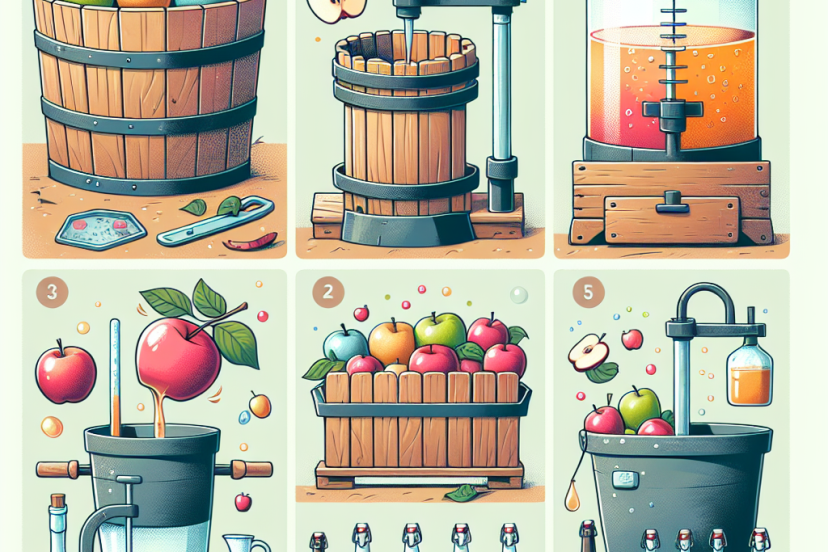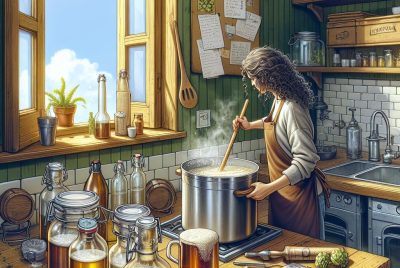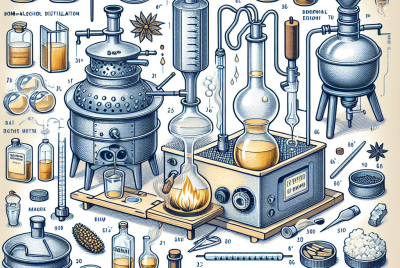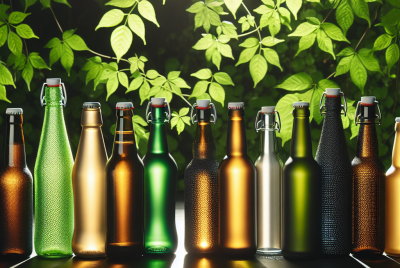A Beginner’s Guide to Making Your Own Cider
If you’ve ever wondered about the art of making your own cider, look no further. In this beginner’s guide, we’ll show you the step-by-step process of creating your very own delicious cider from scratch. From selecting the perfect apples to crushing and fermenting them, we’ll cover it all. Whether you’re a cider enthusiast or simply curious about the process, this article is here to help you embark on your cider-making journey with ease.
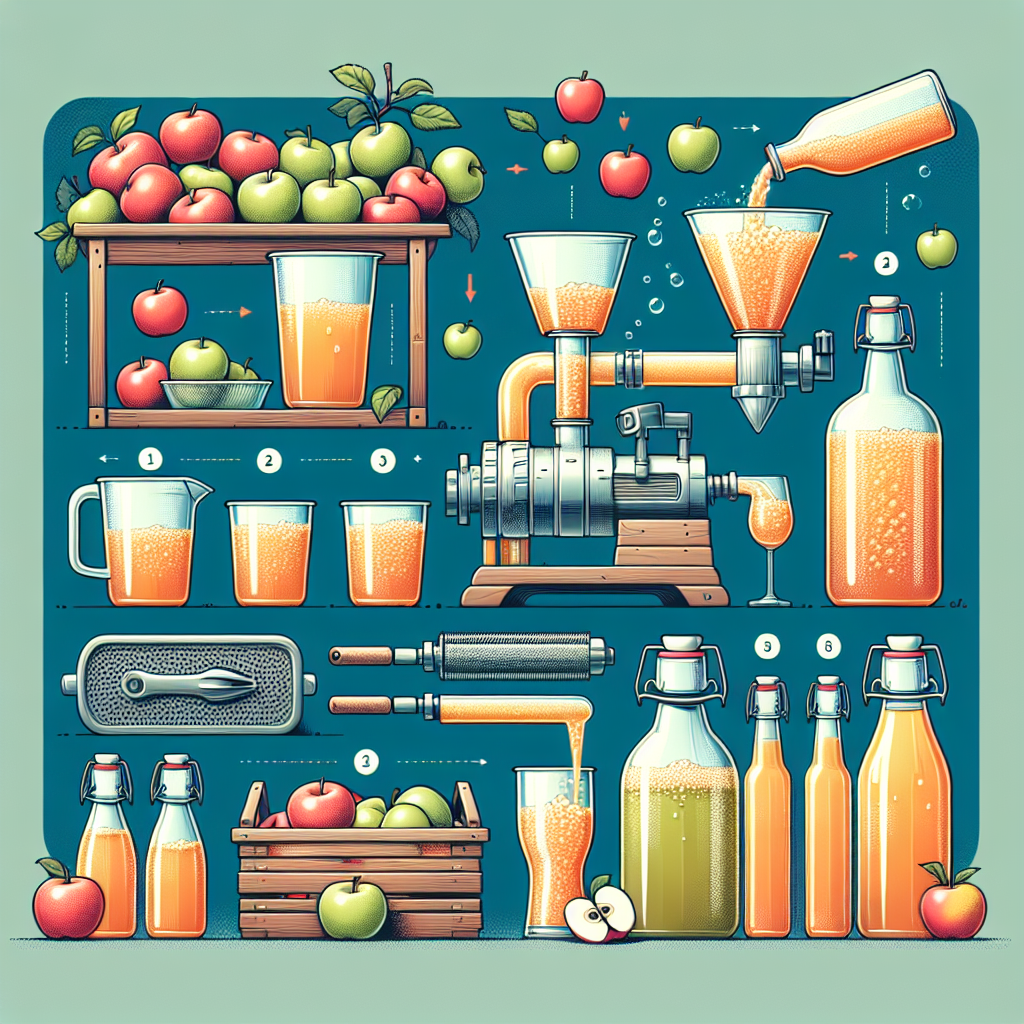
The Basics of Cider Making
Understanding the Cider-Making Process
Cider making is an enjoyable and rewarding hobby that allows you to create your own delicious beverages. The process involves several steps, including selecting the right apple varieties, preparing the apples, fermenting the juice, and adding flavors and sweeteners. In this article, we will guide you through the entire cider-making process, from start to finish.
Equipment Required for Cider Making
Before you begin making cider, it’s important to gather the necessary equipment. Some essential items include a fruit press or grinder, fermentation vessel, airlock, sanitizing solution, hydrometer, and siphoning equipment. These tools will help you effectively process and ferment your cider. Additionally, it’s a good idea to invest in thermometers, measuring cups, and a pH meter, as they can help ensure the success of your cider-making journey.
Choosing the Right Ingredients
The quality of your cider largely depends on the ingredients you use. When it comes to apples, it’s essential to select the right varieties that are specifically suited for cider making. Certain apple varieties, such as bittersweet or bittersharp apples, have the ideal balance of sugar, acid, and tannins for making cider. Understanding the characteristics of different apple varieties and their optimal ripeness will help you create a well-rounded and flavorful cider.
Selecting Apples for Cider Making
Choosing the Right Apple Varieties
Not all apples are suitable for making cider. Specific apple varieties that are often used in cider making include Kingston Black, Dabinett, and Michelin. These varieties are known for their high sugar content, acidity, and tannins, which contribute to the complexity and richness of the final product. It’s important to consult with local orchards or research online to find the best apple varieties available in your region.
Understanding Different Apple Characteristics
When selecting apples for cider making, it’s crucial to consider their sugar content, acidity, and tannin levels. Sugar provides the fuel for fermentation, while acidity adds brightness and balance to the flavor profile. Tannins contribute astringency and complexity to the cider. By understanding these characteristics, you can create a well-rounded and flavorful cider that suits your personal taste preferences.
Optimal Ripeness for Cider Making
The ripeness of apples plays a significant role in the quality of the cider. Apples that are too ripe may result in overly sweet or flat-tasting cider, while underripe apples may lack sufficient sugar content. The optimal picking time for cider apples is when they are slightly underripe, as they will have a good balance of sugar, acidity, and tannins. It’s important to taste the apples to ensure they are at their prime before proceeding with the cider making process.
Preparing Apples for Cider Making
Cleaning and Sanitizing Apples
Before using apples for cider making, it’s essential to clean and sanitize them thoroughly. This helps remove any dirt, debris, or potentially harmful microorganisms. Start by rinsing the apples in cold water to remove surface dirt. Then, sanitize them by soaking them in a solution of water and food-grade sanitizer. Rinse the apples again after sanitizing to ensure no sanitizer residue remains on the fruit.
Pressing vs. Grinding the Apples
Once your apples are clean and sanitized, you have a choice between pressing or grinding them. Pressing involves using a fruit press to extract the juice from the apples, resulting in a higher-quality cider with less sediment. Grinding, on the other hand, involves using a grinder to break down the apples into a pulpy consistency, which is then pressed to extract the juice. Both methods have their advantages and produce great results, so choose the one that suits your preferences and available equipment.
Extracting Juice from Apples
Whether you choose to press or grind the apples, the goal is to extract as much juice as possible. If using a fruit press, load the apples into the press basket and apply pressure to squeeze out the juice. For grinding, feed the apples into the grinder and collect the pulpy mass. You can then press the pulp to extract the juice. Remember to collect the juice in a sanitized vessel, as this will be the foundation for your cider.
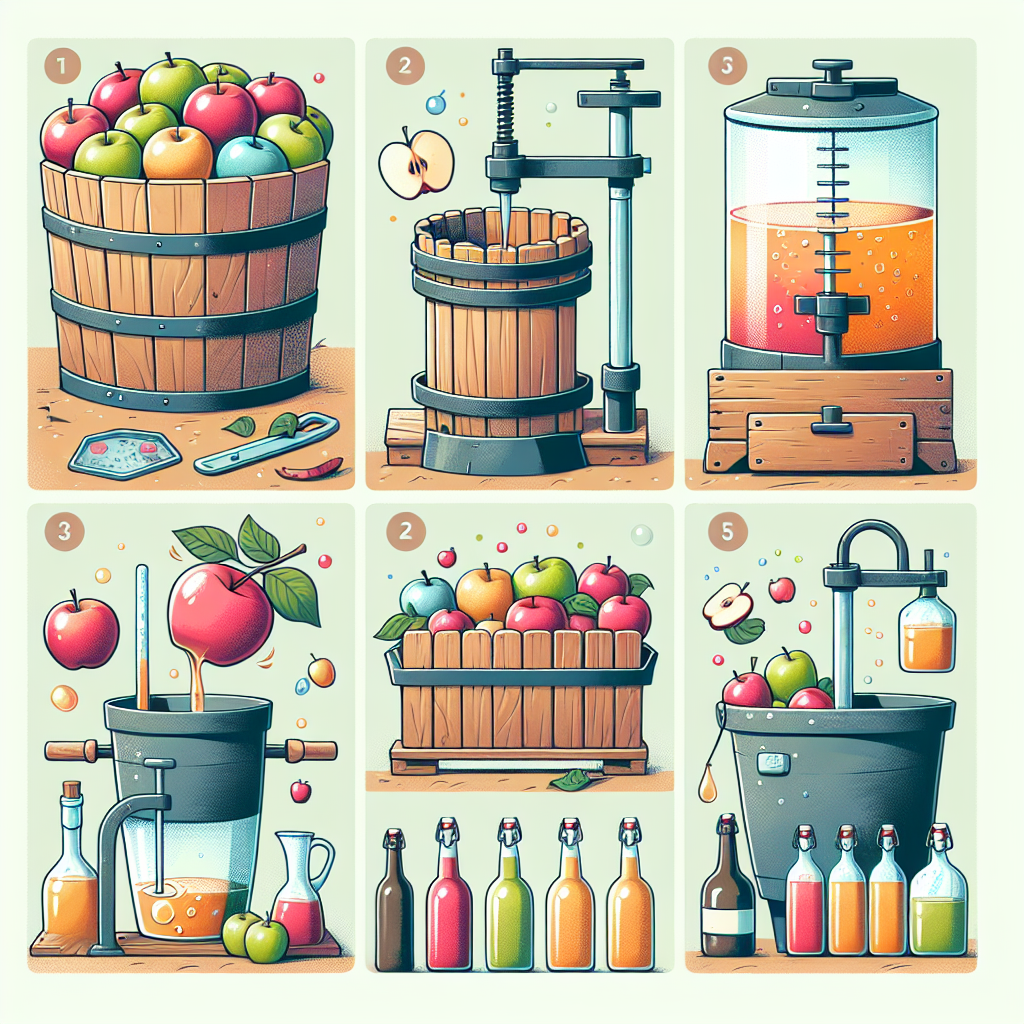
Fermenting Cider
Introduction to Fermentation
Fermentation is a crucial step in cider making that transforms apple juice into delicious cider. During fermentation, the natural sugars in the juice are converted to alcohol by yeast. This process requires a controlled environment and the right yeast selection. Understanding and monitoring the fermentation process is key to producing a high-quality and well-balanced cider.
Yeast Selection for Cider Making
The choice of yeast greatly influences the flavor profile of your cider. Different yeast strains produce distinct flavors, from dry and crisp to fruity and sweet. Some popular yeast options for cider making include Champagne yeast, ale yeast, and cider-specific yeast strains. It’s important to choose a yeast that complements the apple flavors and desired characteristics you’re aiming for in your cider.
The Fermentation Process
To kickstart the fermentation process, add the selected yeast to the apple juice. Ensure that the fermentation vessel is properly sanitized, as cleanliness is important to prevent contamination. Once the yeast is added, insert an airlock into the vessel to allow carbon dioxide to escape while preventing oxygen and potential contaminants from entering. Place the vessel in a cool, dark place and allow fermentation to occur over a designated period of time, usually a few weeks. Monitor the specific gravity of the cider using a hydrometer to track the progress of fermentation. Once fermentation is complete, you can move on to the next steps of cider making.
Adding Flavors and Sweeteners
Understanding Flavor Profiles
Adding flavors and sweeteners can enhance the complexity and taste of your cider. Flavor profiles can vary widely, ranging from traditional and earthy to experimental and fruity. Consider experimenting with ingredients such as spices, hops, fruits, or even oak chips to infuse unique flavors into your cider. Keep in mind that the balance of flavors is key, so start with small additions and taste along the way to achieve the desired result.
Using Additives and Adjuncts
Additives and adjuncts can be used to enhance specific aspects of your cider. For example, pectic enzyme can be added to aid in clarifying the cider, while tannins can be used to enhance astringency. Yeast nutrients can provide additional nutrients to the yeast, promoting a healthy fermentation process. It’s important to follow the recommended usage instructions for any additives or adjuncts you choose to use and consider their potential impact on the flavor and clarity of your cider.
Sweetening Your Cider
If you prefer a sweeter cider, you can add sweeteners after fermentation is complete. Options for sweetening include sugar, honey, or non-sugar alternatives like stevia or artificial sweeteners. It’s essential to add the sweetener in small increments, tasting as you go, until you achieve the desired level of sweetness. Keep in mind that adding sweeteners may reactivate fermentation, so you should consider stabilizing your cider before sweetening to prevent any unwanted carbonation.
Clarifying and Aging Cider
The Importance of Clarification
Clarifying your cider is an important step to achieve a clear and visually appealing finished product. Clarification removes any particles or sediment from the cider, resulting in a more aesthetically pleasing and professional-looking beverage. It also helps improve the flavor and mouthfeel of the cider by removing any unwanted impurities.
Clarifying Agents and Techniques
There are several clarifying agents and techniques that can be used to clear your cider. Fining agents, such as bentonite or gelatin, can be added to the cider to help settle any particles to the bottom of the vessel. Cold crashing, which involves lowering the temperature of the cider, can also aid in clarification by encouraging particles to settle. Additionally, racking or siphoning the cider off the sediment can further improve clarity.
Aging Your Cider for Enhanced Flavor
Aging your cider allows the flavors to mature and develop over time, resulting in a smoother and more refined end product. After clarification, transfer the cider into a secondary vessel for aging. This can be a glass carboy or a stainless steel container. Allow the cider to age for several months to a year, depending on your preference. During this time, flavors will meld together, aromas will evolve, and the cider will become more complex.
Carbonating and Bottling Cider
Options for Carbonating Your Cider
Carbonation adds a delightful effervescence to your cider, enhancing its appeal. There are two primary methods for carbonating cider – natural carbonation and force carbonation. Natural carbonation involves bottling cider that still has residual sugar, allowing fermentation to continue in a sealed bottle and producing carbon dioxide. Force carbonation, on the other hand, requires pressure and a carbonation system to carbonate the cider more quickly.
Bottling Equipment and Techniques
Before you bottle your cider, ensure that your bottles, caps/corks, and other equipment are sanitized to maintain the quality and prevent contamination. Siphon the cider into sanitized bottles, leaving some headspace to accommodate carbonation. Use a bottle filler or a siphon with a bottling wand for efficient and precise filling. Cap or cork the bottles tightly to keep the carbonation intact.
Priming and Conditioning Cider
If you choose natural carbonation, priming is an important step. Priming involves adding a small amount of sugar or another fermentable ingredient to the cider just before bottling. This additional sugar provides the food source for the remaining yeast, allowing them to produce carbon dioxide and naturally carbonate the cider over time. Conditioning refers to the period of time the carbonated cider spends in the bottle to reach the desired carbonation level. This typically takes a few weeks, but the cider can be enjoyed at any point during the conditioning process.
Troubleshooting Common Issues
Preventing Contamination and Off-Flavors
Contamination and off-flavors can occur during the cider-making process, potentially ruining your batch. To prevent contamination, ensure that all equipment is properly cleaned and sanitized. Use food-grade sanitizers and avoid using household cleaners that may leave harmful residues. Properly storing ingredients and maintaining a clean environment will also help reduce the risk of contamination. Off-flavors can be caused by factors such as yeast health, fermentation temperature, or poor ingredient quality. Pay attention to these variables and make adjustments as necessary.
Dealing with Stuck Fermentation
Stuck fermentation can occur when yeast activity slows down or stops completely, resulting in unfermented sugars and a sweeter-than-desired cider. To address this issue, you can try gently stirring the cider to re-suspend the yeast or pitching a different yeast strain to restart the fermentation. Additionally, ensuring a suitable fermentation temperature and providing proper yeast nutrition can help prevent stuck fermentation.
Resolving Carbonation Problems
Carbonation issues can arise if the cider is over-carbonated or under-carbonated. Over-carbonation can cause excessive pressure in the bottles, potentially leading to bottle explosions. To prevent this, store your bottled cider in a cool place and monitor the carbonation process closely. If your cider is under-carbonated, you can try re-priming and conditioning the bottles for a longer period of time.
Storing and Enjoying Your Homemade Cider
Validating Cider’s Readiness for Consumption
Before enjoying your homemade cider, it’s important to ensure it is safe to drink. Validate the cider’s readiness by checking for clear and stable carbonation, absence of off-flavors, and a pleasant aroma. Assess the color, taste, and smell of the cider to determine if it meets your expectations. It’s also a good idea to use a pH meter to test the acidity level, as this can indicate fermentation completion and help gauge the cider’s stability.
Proper Storage and Aging
Once your cider is ready for consumption, it’s crucial to store it properly to maintain its quality over time. Store your bottled cider in a cool, dark place, ideally at temperatures around 50-55°F (10-13°C). This will slow down any further fermentation and aging processes while preserving the flavors. It’s also advisable to store your cider bottles upright to minimize the risk of the corks drying out and losing their seal.
Serving and Enjoying Cider
When the time comes to savor your homemade cider, take a moment to appreciate the flavors, aromas, and hard work that went into its creation. Serve your cider chilled or at room temperature, depending on personal preference. For a more elegant presentation, consider using cider-specific glasses that enhance the aroma and flavor. Share your cider with friends and loved ones, and enjoy the fruits of your cider-making labor.
Advanced Techniques and Experimentation
Blending Different Cider Varieties
For those looking to take their cider-making skills to the next level, experimenting with different apple varieties and blending them can yield exciting results. By combining the unique characteristics of multiple apple varieties, you can create complex and well-rounded ciders that balance sweetness, acidity, and tannins. Keep detailed records of your experiments to replicate successful blends in the future.
Oak Aging and Infusing Flavors
If you’re feeling adventurous, oak aging and flavor infusion can add depth and complexity to your cider. Oak aging involves fermenting or aging cider in oak barrels or using oak chips, which impart flavors such as vanilla, spice, or toasted notes. Flavor infusion allows you to add additional ingredients, such as herbs, spices, or fruits, directly into the fermenting cider to extract unique flavors. These advanced techniques can significantly enhance your cider-making skills and produce truly exceptional beverages.
Exploring Unconventional Ingredients
For those seeking to push the boundaries of cider making, exploring unconventional ingredients can offer a world of possibilities. Consider adding non-traditional fruits, such as berries, cherries, or tropical fruits, to create innovative and imaginative flavors. Spices, herbs, and even hops can also provide intriguing dimensions to your cider. Embrace your creativity and experiment with new flavors and ingredients to create a truly unique cider that reflects your personal taste and style.
Cider making is an art form that allows you to unleash your creativity while enjoying the fruits of your labor. By understanding the basics of cider making, selecting the right ingredients, and experimenting with flavors and techniques, you can embark on an exciting journey to create your own delicious and unique ciders. So gather your equipment, select your apple varieties, and let your imagination run wild as you begin your cider-making adventure. Cheers to the joy of homemade cider!

